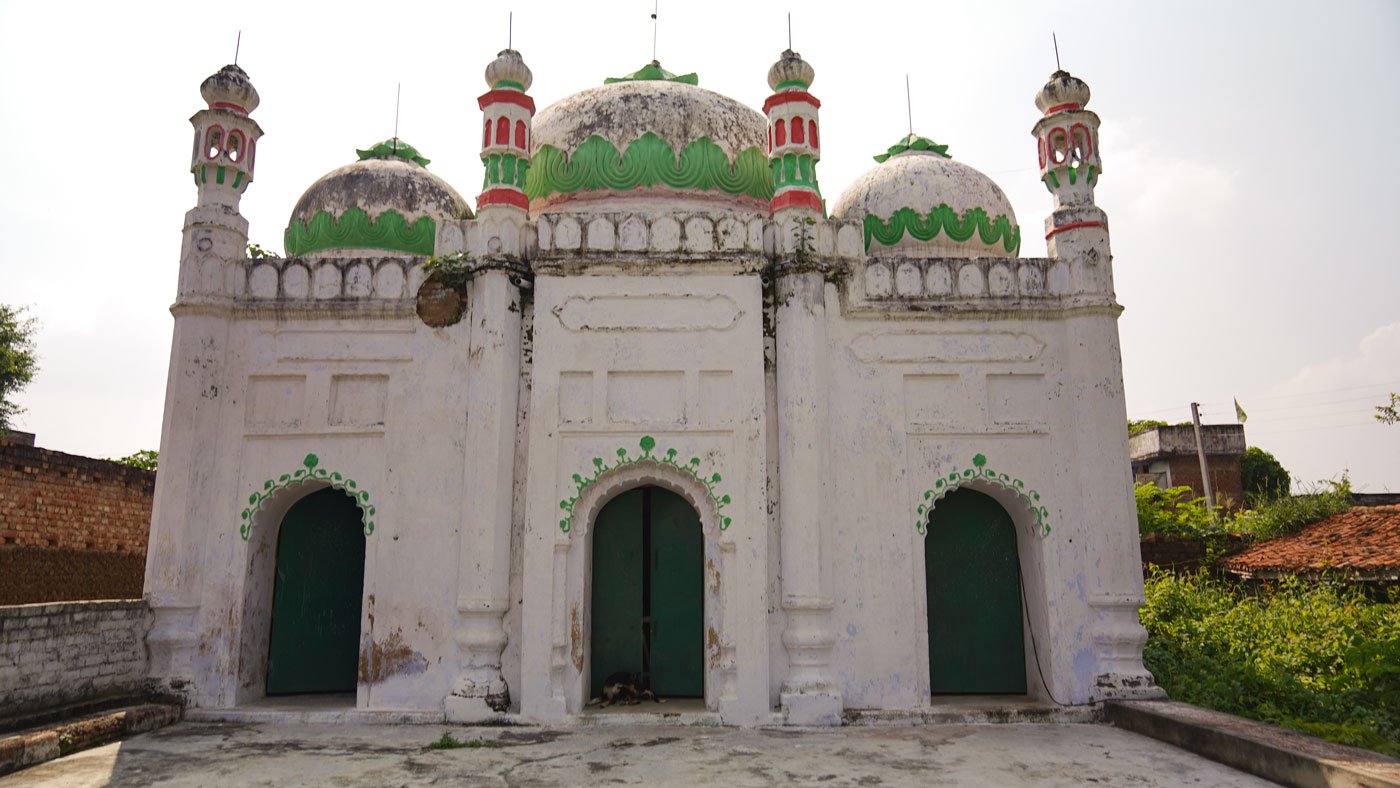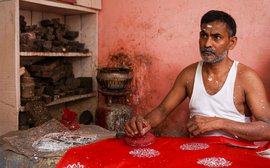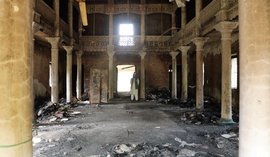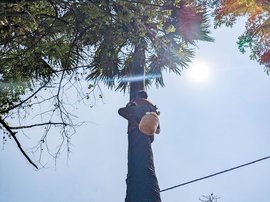Three young men were returning home to Mari after working at a construction site. “It was 15 years ago,” Ajay Paswan, one of them, recalls. “We were passing the deserted mosque in our village, and we thought to see it from inside. We were curious.”
Moss covered the floor and bushes had overtaken the structure.
“ Andar gaye to hum logon ka mann badal gaya [When we entered, our mood changed],” the 33-year-old daily wage worker says. “Maybe Allah wanted us to go in.”
The three – Ajay Paswan, Bakhori Bind and Gautam Prasad – decided to clean it up. “We cut the jungle [wild growth] and painted the mosque. We constructed a big platform in front of the mosque,” says Ajay. They also started lighting the evening lamp.
They trio installed a sound system and hung a
loudspeaker horn on the dome of the mosque. “We decided to play
azan
through a sound system.” adds Ajay,
and soon the
azan
(call to prayer)
for all Muslims, rang out five times a day in Mari, a village in Bihar’s
Nalanda district.


Ajay Paswan (left) along with two other friends decided to take responsibility for the upkeep of the mosque in their village Mari, in Bihar's Nalanda district. Elders in the village (right) say that for centuries, any celebration in the village, even that of Hindus, has always started with worshipping at the mosque and mausoleum
There are no Muslims in Mari village. But the care and upkeep of the masjid (mosque) and mazaar (mausoleum) here are in the hands of Ajay, Bakhori and Gautam – three Hindus.
“Our faith is attached to this masjid and the mazaar , and we protect it,” says Janaki Pandit. “When I was married 65 years ago, I too first bowed my head at the mosque and then worshipped our [Hindu] deities,” adds the 82-year-old resident.
The white and green painted mosque is visible from the main road; its paint fades with every monsoon. A four-foot-high boundary walls surrounds the compound of the mosque and mausoleum. On passing through the large, old wooden door one enters the courtyard of the mosque which holds a Hindi translation of the Quran and a book Sachchi Namaz that explains the methods of praying .
“A groom from the village must first bow his head at the masjid and mazaar and only then pay obeisance to our Hindu deities,” adds Pandit, a retired government school teacher. Even when the wedding procession comes from outside to the village, “the groom is first taken to the masjid . After paying obeisance there, we take him to the temples. It is a mandatory ritual.” Locals offer prayers at the mausoleum, and if a wish is fulfilled, he/she lays a chadar on it.

Mari's mosque was restored 15 years ago by three young men: Ajay Paswan, Bakhori Bind and Gautam Prasad – who cut the wild growth, painted the mosque, constructed a big platform and started lighting the evening lamp. Inside the mosque there is a Hindi translation of the Quran (right) and a booklet on how to offer namaz (daily prayers)


The mausoleum (left) is said to be that of Sufi saint Hazrat Ismail who arrived from Arabia at least three centuries ago. Janaki Pandit (right), a retired school teacher says, 'our faith is attached to this masjid [mosque] and the mazaar [mausoleum], and we protect it'
Fifty years ago, Mari had a small population of people from the Muslim community. They hurriedly left the village after the infamous 1981 communal violence in Bihar Sharif. The riots in April of that year started with a dispute between Hindus and Muslims at a tadi (toddy) shop and 80 people lost their lives.
Although Mari was not touched, the charged atmosphere in the region left Muslims here shaken and unsure. Slowly they moved away, choosing to live in nearby Muslim-dominated towns and villages.
In 1981, Ajay was a teenager and says he doesn't recall much about the riots. “People said that Muslims had left the village then. They didn't tell me why they left the village and if anything happened here. But whatever had happened was not good,” he admits, referring to their complete exodus.
Former resident, Shahabuddin Ansari agrees: “ Wo ek andhad tha, jisne hamesha ke liye sabkuch badal diya [It was a storm that changed everything forever].”
The Ansaris were among the roughly 20 Muslim families that fled Mari in 1981. “My father, Muslim Ansari was a beedi maker at that time. The day the riots broke out, he had gone to Bihar Sharif to bring beedi materials. When he returned, he informed the Muslim families of Mari,” says Shahabuddin.


Ajay (left) and Shahabuddin Ansari (right) in Mari. The latter recalls how a Hindu helped him get his job as postman. Shahabuddin recalling the riots of 1981 that caused Muslims to leave in a hurry says, 'since I was working as a postman in Mari village, I started living in the house of a Hindu family there, but I shifted my father and mother to Bihar Sharif. It was a storm that changed everything forever'
Then in his twenties, Shahabuddin was the postman of the village. Once his family moved out, he switched to running a grocery store in Bihar Sharif town. He says that despite their sudden departure, “there was no discrimination in the village. We all were living together in harmony for so long. No one had any problem with anyone.”
He reiterates that there was and is no enmity between Hindus and Muslims in Mari. “When I visit Mari, many Hindu families insist on my having food at their houses. There is not a single home that does not ask me to a meal,” says the 62-year-old who is delighted that the mosque and mazaar are being cared for.
Mari village in Ben block has a population of about 3,307 ( Census 2011 ), and most are backward class and Dalits. The young men taking care of the mosque: Ajay is a Dalit, Bakhori Bind belongs to the EBC (Extremely Backward Class) and Gautam Prasad is an OBC (Other Backward Class).
“This is the best example of Ganga-Jamuni tehzeeb [composite culture],” says Mohammad Khalid Alam Bhutto. A former resident of the village, the 60-year-old was among those who moved to the nearby Bihar Sharif town. “The mosque is more than 200 years old, and the mausoleum attached to it would be even older,” he points out.
“The
mausoleum is of Hazrat Ismail, a Sufi saint who is said to have come to Mari
village from Arabia. It is believed that before his arrival the village had
been destroyed many times due to natural disasters like floods and fires. But
when he started living here, disaster never returned. After his death, his
mausoleum was built and the Hindus of the village started worshipping,” he
says. “That tradition continues even today.”


Ajay (left) and his friends have hired a person to perform azaan , and they together pay him Rs. 8,000 as a monthly salary from their wages as workers. Right: ' This is the best example of Ganga-Jamuni tehzeeb [composite culture],' says Mohammad Khalid Alam Bhutto, a former resident of Mari
After the Covid-19 pandemic and subsequent lockdowns three years ago, Ajay, Bakhori and Gautam found it difficult to find work in Mari, so they moved to different places – Gautam runs a coaching centre in Islampur (35 kms away) and Bakhori is a mason in Chennai; Ajay moved to Bihar Sharif town.
The trio’s departure affected the maintenance of the mosque. In February 2024, Ajay says azan had stopped in the mosque and so he hired a muezzin to perform azaan . “The job of the muezzin is to perform azan five times a day. We [three] pay him 8,000 rupees as a monthly salary and have given him a room in the village to stay,” he adds.
Ajay has decided to keep protecting the mosque and mausoleum as long as he is alive. “ Marla ke baade koi kuch kar sakta hai. Jab tak hum zinda hain, masjid ko kisi ko kuch karne nahi denge [Anyone can do anything after my death. As long as I am alive, I will not let anyone do anything [harm] to the mosque].”
This story is supported by a fellowship in memory of a trade unionist from Bihar who championed the struggles of marginalised people in the state.



